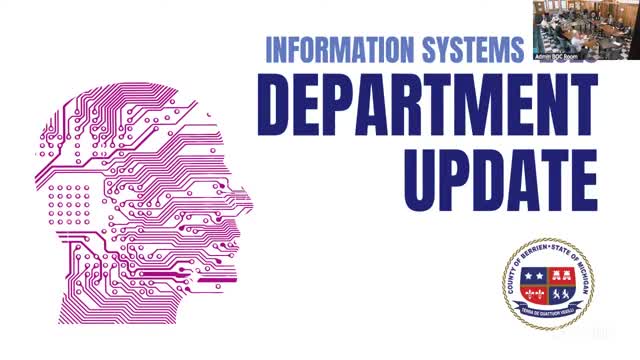County IT reports mainframe elimination, PC upgrades and cybersecurity steps; flags 2026 data-center replacement
October 16, 2025 | Berrien County, Michigan
This article was created by AI summarizing key points discussed. AI makes mistakes, so for full details and context, please refer to the video of the full meeting. Please report any errors so we can fix them. Report an error »

Chris, an Information Systems staffer, told the Berrien County Board that the county completed several large IT projects in 2025 and identified capital needs for 2026.
Chris said the county completed a pension migration that “eliminate[d] the mainframe,” an effort that reduced ongoing mainframe support costs. He also said the county replaced about 225 personal computers that were running Windows 10, and touched several hundred additional machines that could be upgraded to Windows 11.
“Several 100 PCs that we had to touch at the beginning of the year,” Chris said, noting the work as part of broader efficiency efforts. He said staff implemented a new support-ticket policy to increase accountability and track workload across departments.
The department upgraded wireless infrastructure (including improved bandwidth for GIS), replaced several network switches at the health department, and rolled out guest Wi‑Fi at the courthouse with plans to extend guest access to other county buildings. Chris described a near-term schedule of projects: continued Microsoft 365 deployment (next step OneDrive access), phone-system upgrades that will deploy almost 800 phones countywide, an upgrade to the 911 phone system going live next week, and a camera-server upgrade and camera replacements at the courthouse.
On cybersecurity and compliance, Chris said the county is implementing 24/7 monitoring (MDR) through a partnership with federal and industry partners and will require multifactor authentication for applications storing Criminal Justice Information (CJIS) as part of CJIS audit requirements. “One of the things that we have to be able to do is make sure that any of our applications that have CJIS stored in them are being accessed through multi factor authentication,” he said, and explained that the county will require Windows Hello/PIN or equivalent on endpoints to meet that requirement.
Chris flagged large capital items for 2026 including replacement of a six-year-old data center and a proposed mobile operations pad for external agencies (the latter estimated at about $600,000 with cost-sharing and potential grant offsets). He proposed forming an IT project-planning or steering committee with finance and department representatives to prioritize limited resources.
Why it matters: The planned data-center replacement and CJIS-related security work have countywide operational and compliance implications. The projects affect many departments, have notable cost implications in next year’s budget, and require coordination for continuity and disaster-recovery testing.
Chris said the county completed a pension migration that “eliminate[d] the mainframe,” an effort that reduced ongoing mainframe support costs. He also said the county replaced about 225 personal computers that were running Windows 10, and touched several hundred additional machines that could be upgraded to Windows 11.
“Several 100 PCs that we had to touch at the beginning of the year,” Chris said, noting the work as part of broader efficiency efforts. He said staff implemented a new support-ticket policy to increase accountability and track workload across departments.
The department upgraded wireless infrastructure (including improved bandwidth for GIS), replaced several network switches at the health department, and rolled out guest Wi‑Fi at the courthouse with plans to extend guest access to other county buildings. Chris described a near-term schedule of projects: continued Microsoft 365 deployment (next step OneDrive access), phone-system upgrades that will deploy almost 800 phones countywide, an upgrade to the 911 phone system going live next week, and a camera-server upgrade and camera replacements at the courthouse.
On cybersecurity and compliance, Chris said the county is implementing 24/7 monitoring (MDR) through a partnership with federal and industry partners and will require multifactor authentication for applications storing Criminal Justice Information (CJIS) as part of CJIS audit requirements. “One of the things that we have to be able to do is make sure that any of our applications that have CJIS stored in them are being accessed through multi factor authentication,” he said, and explained that the county will require Windows Hello/PIN or equivalent on endpoints to meet that requirement.
Chris flagged large capital items for 2026 including replacement of a six-year-old data center and a proposed mobile operations pad for external agencies (the latter estimated at about $600,000 with cost-sharing and potential grant offsets). He proposed forming an IT project-planning or steering committee with finance and department representatives to prioritize limited resources.
Why it matters: The planned data-center replacement and CJIS-related security work have countywide operational and compliance implications. The projects affect many departments, have notable cost implications in next year’s budget, and require coordination for continuity and disaster-recovery testing.
View full meeting
This article is based on a recent meeting—watch the full video and explore the complete transcript for deeper insights into the discussion.
View full meeting
